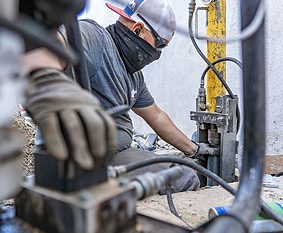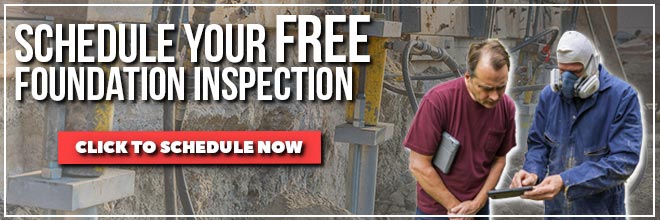If you’ve been around the construction/engineering block a time or two, then you’re definitely familiar with the technical term underpinning.
And, if you’re an avid WWE fan, you know that underpinning is not the Undertaker’s signature move – that’s The Tombstone Piledriver (which kind of sounds like a big bad CAT we’d utilize here at Dalinghaus to drive Piers).
The truth is, the term underpinning has a broad, sweeping range that encompasses a lot of factors that have to do specifically with foundation repair and foundation settlement.
Check out our comprehensive Ultimate Guide to Foundation Repair that covers underpinning in great depth.
Click on the link below to download our FREE printable checklist for foundation settlement symptoms –
This article will be an exhaustive exposé on underpinning and will cover:
- Underpinning’s Definition
- Reasons for Underpinning
- A short history on Underpinning
- Types of underpinning
- Mass Concrete Underpinning
- Beam and Base Underpinning
- Mini-Piled Underpinning
a. Push Piers
b. Helical Piers
c. Helical Tiebacks - Alternatives to underpinning
- Why homeowners need underpinning
So, sit back, relax, and enjoy the folding-chair-throwing-mania of UNDER-pinning!
Underpinning Definition
What is underpinning?Underpinning is strengthening and reinforcing an existing foundation of a structure, typically by extending the depth and breadth of the foundation. |
Underpinning gets its name because the underpinning procedure is performed in stages so as not to compromise the entirety of the structure’s integrity at once.
The excavation of the soil is carried out in phases referred to as pins.
(*Note – whether it is mass pour or beam or mini pile underpinning, all are completed in sections).
I like to think of it as sticking pins into a corkboard to keep a piece of paper in place or clipping on clothesline pins to keep laundry up – the important idea to take away from this term is multiple pins provide stability.
Reasons for underpinning?
There is a long litany of reasons why underpinning needs to be undertaken. Here is a shortlist to help us understand underpinning’s unique utilities.
A structure might require underpinning if –
- The original foundation isn’t strong/stable enough to support the existing structure
- The initial use of the structure has changed, requiring foundational reinforcement
- The soil is not competent to withstand the weight of the structure
- Another story is being added to the structure, requiring deeper foundational footings to help support greater load-bearing capacity
- It is cheaper to repair/reinforce than buy new
- Seismic activity, drought, flood, or other acts of God have compromised the structure’s structural security
A simple way to think about underpinning is this: any outside force that compromises the strength, integrity, and functionality of your foundation/footing is a reason to underpin (provide reinforcement/structural support).
Note – If you’re not sure your home requires underpinning, you should look for the tell-tale signs and symptoms of foundation settlement.
History of Underpinning
Underpinning is old-school, and I mean real old – older than dirt.
Underpinning, in terms of structural & architectural engineering, has been around for well before the 15th century.
In fact, the great Italian Renaissance humanist and architect Leon Battista Alberti outlined the extensive benefits of underpinning his comprehensive treatise on theory and practice of architecture De Re Aedificatoria (On the Art of Building) published in 1452.
It has long been a tradition to restrengthen bridges, tunnels, skyscrapers, and homes by use of underpinning.
A more modern example of underpinning is the story of the antiquated Hotel Commodore (designed by the highly celebrated Homer G Balcom who also designed the Empire State Building).
The Hotel Commodore, built in 1917, was erected right above (and, consequently, supported by) the Grand Central Station subway structure.
In 1979, the Hotel Commodore underwent an extensive refurbishment before resuming business under the new appellation Grand Hyatt.
This renovation proved extreme and required space to be opened up for an increase in headroom at the subway mezzanine level (intermediate floor) to improve passenger outflow.
This required extensive underpinning and significant load transfer of the hotel above by temporary support, sequencing, and jacking.
In short, underpinning allows for modern architectural miracles.
And, the kind of sad part is, you never see it (because it’s underground). In that way, it’s kind of like the ever-elusive John Cena – you can’t see me.
Types of Underpinning
There is a general consensus among architects, engineers, and construction workers that there are three primary types of underpinning:
1. Mass Concrete Underpinning/Mass Pour
Mass Concrete underpinning is perhaps the oldest, most frequently utilized foundation repair method on the planet.
This involves digging holes/voids underneath a weakened foundation and pouring new mud/concrete/filler below the original foundation.
This extends depth and breadth of the foundation, providing extra inherent support.
This is simple. Basic. Gets the job done. You can chalk it up to – dig a hole underneath the existing foundation and fill it up with supporting material.
2. Beam and Base Underpinning
This is a newer form of underpinning where a reinforced concrete/steel beam is constructed below, above, or in replacement of the existing footing.
The beam then transfers the weight of the building to these concrete/metal bases which have been positioned in strategic load-bearing locations.
This is slightly more sophisticated than mass concrete underpinning in that it’s essentially adding a new concrete/steel base to an older one, not replacing it.
3. Mini-piled Underpinning
This type of underpinning allows for the greatest flexibility in regard to where access is limited/restricted and environmental pollution is significant.
Mini-piled underpinning is typically when the load of the structure needs to be transferred to more competent load-bearing soil at a greater depth (occasionally as deep as 50 feet).
This originated in Italy back in 1952 and had undergone many different variations under numerous names and patents.
So, yeah, it might or might not be a Mafia thing…(as alluded to in our 25 Questions to Ask When Hiring a Foundation Repair Contractor).
This is the kind of underpinning we generally do here at Dalinghaus Construction Inc. with our:
1. Push Piers
Hollow, cylinder tubes typically 30 inches long and comprised of hot-dipped-galvanized steel, with a maximum load capacity of 68 thousand pounds.
These are pushed via drive head to load-bearing stratum and attached to the footing of the structure with a remedial bracket.
Square or round tubes typically 30 inches long and comprised of hot-dipped-galvanized steel, with helices welded to the bottom to provide extra support and a maximum load capacity of 74 thousand pounds.
These are screwed into the earth until they reach competent, load-bearing stratum and then attached to the footing of the structure with a remedial bracket.
Square tubes that vary in size, typically comprised of hot-dipped-galvanized steel, have helices/flights, and are driven into the earth at an angle to act as an anchor.
Helical tiebacks are rods implemented to support, strengthen, anchor, and straighten retaining walls or bowed basements and can have a maximum load capacity of up to 200,000 pounds.
These are screwed into the earth until they reach competent, load-bearing stratum and then secured via a whaling plate.
This is the most complex version of underpinning, as it involves a wide variety of tools and resources for application.
In simplistic terms, imagine putting your house on underground stilts.
These stilts are driven into load-competent soil or bedrock, providing deep-rooted support for your foundation.

Alternatives to Underpinning
As the definition of underpinning pertains specifically to the reinforcement/strengthening of the foundation itself, alternatives attempt to strengthen the soil.
We see this by the introduction of grout and other urethane-based chemicals that expand – such as Polyurethane.
Mudjacking
The raising of pavement/concrete/slabs by means of pumping mud/slurry (concrete) under it through drilled holes. The pressure of the expanding mud raises the pavement in elevation.
Grout injection
This method of foundation repair is where grout is injected directly into the soil, changing the chemical makeup of the adjacent native soils so that they develop low viscosity.
The grout/chemical is typically injected via a sleeve port pipe which is inserted into a pre-dug hole.
The grout is henceforth pumped out and allowed to permeate the soil, essentially calcifying the affected area so that the soil is stronger, thicker, and less permeable.
Just remember Kayne’s number one hit single “Stronger.” The goal is to make the ground harder, better…stronger.
These are not great alternatives to underpinning.
Mudjacking and using polyurethane material is not a long-lasting solution to your problem.
And, considering homes stick around for quite a while, it’s better to go the more permanent route.
Why Homeowners Need Underpinning
Homeowners may require underpinning due to foundation settlement – this is where your home sinks into the earth due to expansive soil, poor irrigation, and a litany of other factors.
Homeowners usually underpin because:
- It stops their house from further settlement
- They are tired of sinking money into recurrent cosmetic repairs
- It adds property value to the home (a settled home can lose 30% of its total value on the market – yikes!)
A home is a huge investment due to its durability and transferability via inheritance or sale. Underpinning is generally a long-term repair method.
Underpin with Dalinghaus
At Dalinghaus Construction Inc., we believe that underpinning is such a long-term solution we even have a lifetime warranty!
So, for those of you who live in Southern California and Central Arizona, click the link below to receive a FREE foundation inspection –







